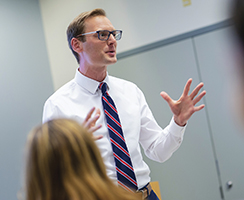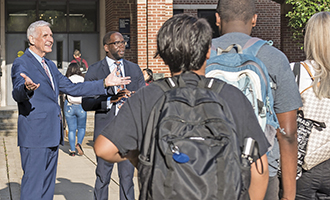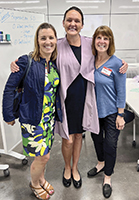Getting Unstuck on the Path of Organizational Change
September 01, 2022
Strategic leaders anticipate and navigate the challenges of change

Change is hard. It is complex, messy and contextual. With no one right way to proceed, it is very easy to get stuck.
Eric Witherspoon, who spent 16 years in the superintendency of the Evanston Township High School District in Evanston, Ill.,
is unequivocal when looking back over his career in leadership roles. He worked for more than 30 years in multiple districts on a journey leading change focused on equity in the schools.
“It is easy to get lost and feel defeated as
a leader if one just focuses on the incredible magnitude of the work,” he says. “Equity work touches and transforms all parts of the system. It weighs heavy on the leader and requires more and different work from everyone.”
The candid reflections of this veteran superintendent, who retired over the summer, represent similar sentiments from other school district leaders across the country. While contexts and change efforts differ, the leaders report remarkably similar
challenges to those of Witherspoon.
Inherent Contradictions
Bringing about positive change can be messy, taxing and full of contradictions. We want our leaders to boldly face complex challenges but also communicate in clear and direct ways. We expect our leaders to take on complicated problems, but we don’t
tolerate mistakes. We expect quick fixes and rapid results without changing too much too quickly. We want direction and clarity, even though change requires us to embark into the unknown.
Unfortunately, the leadership stories we typically
hear in K-12 education fail to capture these contradictions and the tremendous challenges inherent in leading change. Even those invested in the work prefer to hear succinct recommendations or conclusions rather than the painful realities, missteps
and failures so many of us face. But we believe that being aware and prepared to face the messiness of our change efforts is essential to leadership success.
To help better understand the challenges leaders face, we have identified four
main areas within which organizational change efforts can get stuck. These ideas come from our interactions and conversations with leaders as we attempt to support and learn alongside those who are working through change.
The four areas
are (1) making sense of the problem or opportunity, (2) generating potential change strategies, (3) prioritizing and implementing strategies, and (4) learning and adapting. While these challenges may be frustrating, school system leaders can learn
about their system and the nature of the challenge by leaning into them rather than backing away.
Making sense of the problem
Put simply, change is all about navigating from a current state to a future desired state. A school district may face a particular problem it wants to address or may have identified an opportunity it wants to pursue. When all stakeholders within a system have a clear and com-mon understanding of the problem or the opportunity, the change process may be much easier. In reality, this is rarely the case.
- Challenge 1: Problem disagreement. Where some stakeholders see a problem, others see value in the status quo. Systems are designed and maintained to achieve certain goals. Without understanding the goals and needs being met in the
current state, leaders are likely to miss potentially powerful forces that will work hard against change efforts.
Consider, for instance, the school district that is attempting to alter school start times in response to research that suggests a later start time might be beneficial to students. Quickly, leaders hear from parents concerned with how this change will impact their morning routines. Addressing the perceived problem of an early start could lead to new problems for families. When leaders go about the important process of defining and understanding a problem or opportunity, it’s likely they also discover reasons that help explain why things are the way they are. - Challenge 2: Analysis divergence. Even when we collectively acknowledge a problem, we may have very different understandings of why the problem exists. Consider a leader who was attempting to address what they perceived to be a severe
mental health crisis within the district. Administrators believed the increase in staff absences was leading to teachers being stretched too thin, teachers believed disruptions in schooling were leading to student behavior challenges, and students
shared a sense they were losing autonomy and reported that classroom environments felt sterile and impersonal.
It’s essential to note that each one of these problem framings would imply a very different set of strategies. In reality, each stakeholder sees a part of the problem, and no one sees all of it. Leaders, therefore, must intentionally draw insights from individuals who are able to share diverse perspectives, especially from those who are most directly impacted by the problem and those who will be instrumental in helping usher the change.

Generating potential change strategies
Just as different stakeholders will have unique perspectives on how they understand the problem or opportunity, they also will have widely varying theories about what will work to address it. Leaders thus must consider which pathways represent the most promise within their districts.
- Challenge 3: Strategy dispute. Based on their own experiences and beliefs, individuals develop different hypotheses about what efforts will lead to various changes. Consider the current challenge of teacher shortages. There are very
different ideas about how to effectively address the problem, ranging from increasing salaries to decreasing teaching loads to offering more autonomy and flexibility to providing more support and resources.
Baked into each one of these strategies is a hypothesis that connects actions with outcomes. It’s helpful for leaders to work with others to articulate clear and compelling “theories of change” that hold the greatest potential for success. - Challenge 4: Vision confusion. Many leaders assume that good ideas will sell themselves. Yet, this is rarely the case. Change can feel scary and uncertain for many, and if we are expecting others to go along on that journey, we need to help them see why. In building strong coalitions for change, leaders should engage others throughout the entire process and clearly and continuously communicate values, commitments, and a coherent vision behind the change.
Prioritizing and implementing strategies
Good ideas alone are never enough. Effective implementation of good ideas is what leads to progress. As Witherspoon, the veteran superintendent, states, “Getting the proposal passed is only the tip of the iceberg. Making it happen is the really hard work.” There are many areas where leaders can get stuck when implementing change, including overestimating their system’s capacity and degree of community support.
- Challenge 5: Limited capacity. Capacity frequently becomes the limiting factor for many change efforts. Capacity can take the form of tangible resources, such as money, space and technology, or of intangible resources, such as knowledge, attention and energy. It’s common to underestimate the level of resources needed to implement a change, such as the staffing required or the cost of materials. However, it may be even more difficult to anticipate capacity issues related to emotional energy and attention. Several leaders shared that they had to put major change efforts on hold because their teachers were simply stretched too thin and weren’t able or ready to focus their attention or energy on anything new.
- Challenge 6: Misjudged resistance. Leaders frequently underestimate resistance to change. A first-year superintendent indicated when it came time to implement a new school-day schedule, even though the recommendations were grounded
in community input and extensive analysis by teachers over multiple years, the teachers’ union resisted, arguing that the contract needed to be re-negotiated before the schedule could be changed. Another leader reported the need to take
a pause after years of extensive research and preparation toward implementing a standards-based grading policy. The political climate in the community had shifted and no longer was there support for moving forward.
Leaders must acknowledge the true demands a change effort will place on their community and how those demands stack up to their organization’s capacity. This requires leaders be cognizant of what a given change initiative is asking people to unlearn and learn.
For many, change is an emotional experience, where people may be asked to give up familiar practices in exchange for uncertainty and ambiguity. As such, leaders ought to be thoughtful and disciplined with prioritizing a given effort over another. As Stacey Childress, author of Note on Strategy in Public Education, writes, “Strategy is about choosing — choosing what to do, and just as importantly, choosing what not to do.”

Learning and adapting
Leading change is an iterative process, where problems are identified, strategies are developed and deployed, and things happen. Successful implementation requires leaders to be in tune with the outcomes of their leadership actions. Sometimes, however, leaders don’t know if their strategies are working and may find waning interest and support for the change efforts.
- Challenge 7: Success uncertainty. It is not surprising that educators within a given district may offer mixed reviews regarding whether a particular change effort is successful. Unlike a sports competition with a clear purpose and
a quantifiable score, many change efforts in education center around broader purposes with multiple measures of success, many of which are left implicit or unstated.
Several leaders lamented that after multiple-year efforts to improve equity within their schools, teachers and community members were mixed on whether their efforts were successful. In fact, it’s not uncommon for half of the community to be inspired by progress and the other half to feel like they’ve moved backward.
At the onset of a change effort, leaders can facilitate discussions with stakeholders on what success would look like, pushing individuals to get as clear and specific as possible on what would be true if their efforts were to succeed. - Challenge 8: Waning commitment. Significant change generally requires concerted and prolonged effort. Change can make people feel forced into a state of ambiguity and uncertainty, and many are not willing to tolerate that discomfort for too long. In such a context, it can be difficult for people to stay committed and engaged. Some discomfort is a given, but leaders who act strategically can help by acknowledging it, keeping the community’s focus on the goals, celebrating the progress, and empowering those most impacted by the change to learn new ways of working.
Broader Visions
Throughout his extensive tenure as a superintendent, Witherspoon worked enthusiastically and strategically to shape a culture of acceptance, belonging, equity and constant learning. When navigating the challenges of organizational change, perhaps this is the most significant contribution a leader can make: to ground change efforts in a broader inspiring vision and to develop and nurture a culture that allows an organization to reflect, learn and remake itself.
@marybherrmannAbout the Authors
Mary Herrmann, a former superintendent, is a teaching associate professor of education policy, organization and leadership at University of Illinois in Champaign, Ill.
Zachary Herrmann is executive director of the Center for Professional Learning and a member of the professional faculty at the University of Pennsylvania Graduate School of Education in Philadelphia.
Defining and Analyzing a Problem or Opportunity
There are many ways we can work to avoid getting stuck with an ill-defined problem. Essentially, we must ask ourselves: What problem are we trying to solve?
Through problem analysis, leaders can uncover root causes, not just symptoms. Various
discussion tools and processes can help leaders get to the deeper issues and avoid the inclination to quickly treat the most visible concerns. What is visible to us is often symptomatic of larger problems that need attention.
One example
of an efficient tool to help us drill down and get a better understanding of the root causes of a problem is the 5 whys technique. Essentially, when a problem surfaces, you uncover a better understanding of it by asking why no fewer than five times
until you can uncover something you can impact or control. When using the 5 whys, the fishbone diagram, or any other technique to better understand and define the problem, the leader should explicitly challenge the team to support any claims with
evidence: How do we know that is true? What evidence do we have? What assumptions are baked into that claim?
Engaging in root-cause analysis can help people better understand the problem and surface a more complex picture of how the problem
came to be. Be cognizant, though, that while it might be satisfying to assume our problem stems from a single root cause, the reality of complex systems is that problems occur from a complex interaction of various elements of the system. There likely
isn’t a sole cause of the problem — there are many.
In all circumstances, however, the effective use of various tools and processes is highly dependent on organizational culture and conditions. To lead problem-solving and opportunity-seeking
work, leaders should ensure their problem-solving teams and groups are richly diverse and feel psychologically safe. Organizational psychologist Amy Edmondson of Harvard University defines psychological safety as “a shared belief held by members
of a team that the team is safe for interpersonal risk taking.” A diverse and psychologically safe team can be empowered to elicit multiple perspectives, engage in respectful and vigorous debate, and stimulate divergent and critical thinking.
Learning and Adapting: Enthusiasm, Stamina and Resilience
The many school district leaders who shared with us their insights related to leading change exhibited a few common characteristics. These included the enthusiasm they had for the work, the ability to have a long view of change and their incredible capacity
for resilience in the face of setbacks.
Eric Witherspoon, who spent 16 years as superintendent of the Evanston Township High School District in Evanston, Ill., put it this way: “I carry my excitement to everyone in the organization
and remind myself that even on the toughest days, and there are many when leading for equity, every experience, regardless if it is a success or failure, is an opportunity to learn.”
One way Witherspoon builds stamina for the work
is by continuously reframing it and breaking it down into smaller steps that are easier to understand, communicate and manage. “Our efforts are reflected on our (district) website as a living Google document, where questions are answered and
new ones raised continuously, in an ongoing conversation with our community that inspires deeper learning for all of us,” he says.
Superintendent Margaret Clauson, who has spent seven years in that role in Skokie, Ill., echoed sentiments
of keeping the mission core and investing for the long haul, especially when faced with setbacks. When a nonprofit group supporting youth in her area lost its funding, she saw it as an opportunity for the school district to rethink the role of the
schools within the community.
Clauson built alliances and cultivated grassroots efforts to shift the district’s orientation to a broader, shared service mission of community schooling to help strategically address significant problems
such as food insecurity. Broader change efforts such as these require leaders to build commitment to a broader vision for the role and purpose of schools within the community.
Other superintendents shared with us their feelings of disappointment
when their systemwide structural changes (e.g., flexible schedules and standards-based grading initiatives) were put on hold after years of intensive study and preparation. Although initially discouraged, these leaders were able to reframe these setbacks
as momentary pauses and opportunities for new learning. They were quick to adapt and apply their new learning to the work of creating new pathways forward.
Advertisement
Advertisement
Advertisement
Advertisement



